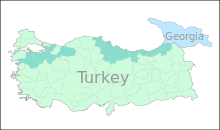Georgians in Turkey
 Map of ethnic Georgians significant distribution in Turkey | |
| Total population | |
|---|---|
| 100,000[1][2]–1,500,000[3][4] | |
| Regions with significant populations | |
| Black Sea Region, Marmara Region, Eastern Anatolia Region | |
| Languages | |
| Georgian, Turkish | |
| Religion | |
| Predominantly Sunni Islam, minority Orthodox Christianity | |
| Related ethnic groups | |
| Laz people |
Georgians in Turkey (Georgian: ქართველები თურქეთში) refers to citizens and denizens of Turkey who are, or descend from, ethnic Georgians who originate in Georgia.
History

Chveneburi had arrived in Turkey basically in three waves of migration due to pogroms and what is now termed ethnic cleansing of Caucasians by the Russian Empire. The first wave was during and after the Russo-Turkish War, 1828-1829 when the Sublime Porte consigned its sovereignty over several parts of Georgia to the Russian Empire. Minor immigrations had also followed until the end of Russo-Turkish War, 1877–1878 when Ottoman Empire allowed Chveneburi to immigrate, the major wave of immigration involved at least 500,000 people from historic Georgian regions that had considerable Muslim populations such as Batumi and Kars.[5] This wave of being muhajirs, known as muhajiroba (მუჰაჯირობა) had left many Muslim-majority regions of Georgia virtually depopulated. The last sizable wave of immigration was in 1921 when Turkey finally gave up its claims on Adjara in the Treaty of Kars with the Soviet republics. This last wave also involved Turkish-speaking Muslims from Upper Adjara. Adjarians were also known by their places of origin, such as Batumlular for people from Batumi, Çürüksulular for people from Kobuleti.
Numbers and distribution

In the census of 1965, 34,330 Turkish citizens spoke Georgian as mother language. Proportionally, they were most numerous in Artvin (3.7%), Ordu (0.9%) and Kocaeli (0.8%). 4,042 of these could only speak Georgian. Another 44,934 spoke Georgian as second best language.
Georgians live scattered throughout Turkey, although they are concentrated on two major regions of residence:[7]
- Black Sea coast, in the provinces Giresun, Ordu, Samsun, and Sinop, with extension to Amasya and Tokat. Chveneburi, particularly in Fatsa, Ünye, Ordu, Terme, and Çarşamba, largely preserve their language and traditions.
- Northwestern Turkey, in the provinces Düzce, Sakarya, Yalova, Kocaeli, Bursa, and Balıkesir.
Magnarella estimated the number of Georgians in Turkey to have been over 60,000 in 1979.[8]
Chveneburi
Chveneburi (Georgian: ჩვენებური, çveneburi), meaning "of us" in Georgian, is an autonym of Muslim immigrants of Georgian descent who had settled in non-Georgian majority regions of Turkey, thus, "of us" signifies a triple distinction from Christian Georgians, Muslim Turks, and autonomous Muslim Georgians. As with most Turkish citizens, most Chveneburi subscribe to the Hanafi madh'hab of Sunni Islam.
Press
The most important Georgian cultural magazine in Turkey also bears the name Çveneburi. It was founded in 1977 in Stockholm, Sweden by Shalva Tevzadze. It is distributed in Turkey by Ahmet Özkan Melashvili, who also wrote the book Gürcüstan (Georgia) in 1968. In 1980, Özkan was assassinated in Bursa by the Grey Wolves.[9] Since then, Osman Nuri Imedashvili has been in charge of the magazine. The magazine's content is almost completely in Turkish and presents articles on Chveneburi as well as the present situation and the history of Georgia and Georgians worldwide. Another journal, Pirosmani, bilingual in Georgian and Turkish, is published in Istanbul, sponsored by the Georgian Catholic Simon Zazadze.
Group identity
Group identity is shaped basically by the schism with Christian Georgians. Chveneburi usually restrain from using the word Kartveli (ქართველი) as a self-designation because they think it indicates being a Christian.[10] They prefer to use Gurji (Gürcü) (გურჯი) when referring to their more precise ethnic background.
Intermarriage with other Sunni groups is common. In some regions, specifically Ünye for instance, Chveneburi women are sought-after brides, seen by the local rural Turkish population as beautiful and hard-working wives. This phenomenon further accelerates cultural and linguistic assimilation of the community.
See also
- Georgia-Turkey relations
- Peoples of the Caucasus in Turkey
- Islam in Georgia
- Adjarians
- Pontic Greeks
- Hamshenis
- Laz people
- Iranian Georgians
- Pirosmani
- List of Georgians
References
- ↑ The Other Languages of Europe: Demographic, Sociolinguistic, and Educational Perspectives, p. 420, at Google Books
- ↑ Ethnic Groups Worldwide: A Ready Reference Handbook, p. 291, at Google Books
- ↑ Ethnic groups in Turkey: Georgians
- ↑ "Türkiyedeki Kürtlerin Sayısı!". Milliyet (in Turkish). 2008-06-06. Retrieved 2008-06-07.
- ↑ "Muhacir Gürcüler yada Çveneburiler - მუჰაჯირი ქართველები ან ჩვენებურები". Çveneburi. Retrieved 28 May 2014.
- ↑ BERAT YILDIZ, EMIGRATIONS FROM THE RUSSIAN EMPIRE TO THE OTTOMAN EMPIRE: AN ANALYSIS IN THE LIGHT OF THE NEW ARCHIVAL MATERIALS, BILKENT UNIVERSITY
- ↑ "Türkiye'deki Gürcü Köylerinde Alan Çalışmasının Sonuçları". Çveneburi. Retrieved 28 May 2014.
- ↑ Peter A. Andrews & Rüdiger Benninghaus (1989), Ethnic Groups in the Republic of Turkey, Vol. 1, p. 174. Reichert, ISBN 3-88226-418-7.
- ↑ .
- ↑
- Black Sea: Encyclopedic Dictionary (Özhan Öztürk. Karadeniz: Ansiklopedik Sözlük. 2. Cilt. Heyamola Publishing. Istanbul. 2005. ISBN 975-6121-00-9.)
- Paul J. Magnarella, The Peasant Venture: Tradition, Migration and Change among Georgian Peasants in Turkey. (Schenkman Publishing Company: Cambridge, MA, 1979) ISBN 0-8161-8271-X
- Mikaberidze, Alexander (ed., 2007). Özkan, Ahmet. Dictionary of Georgian National Biography.
External links
- Chveneburi
- Pirosmani / ფიროსმანი
- Gezgin, Ulas Basar (2004) Republican and Post-Republican Responses to New Georgian Nationalisms (PhD Proposal in Anthropology). teori.org (includes a list of selected publications on the Georgian communities of Turkey)
| Wikimedia Commons has media related to Georgians in Turkey. |